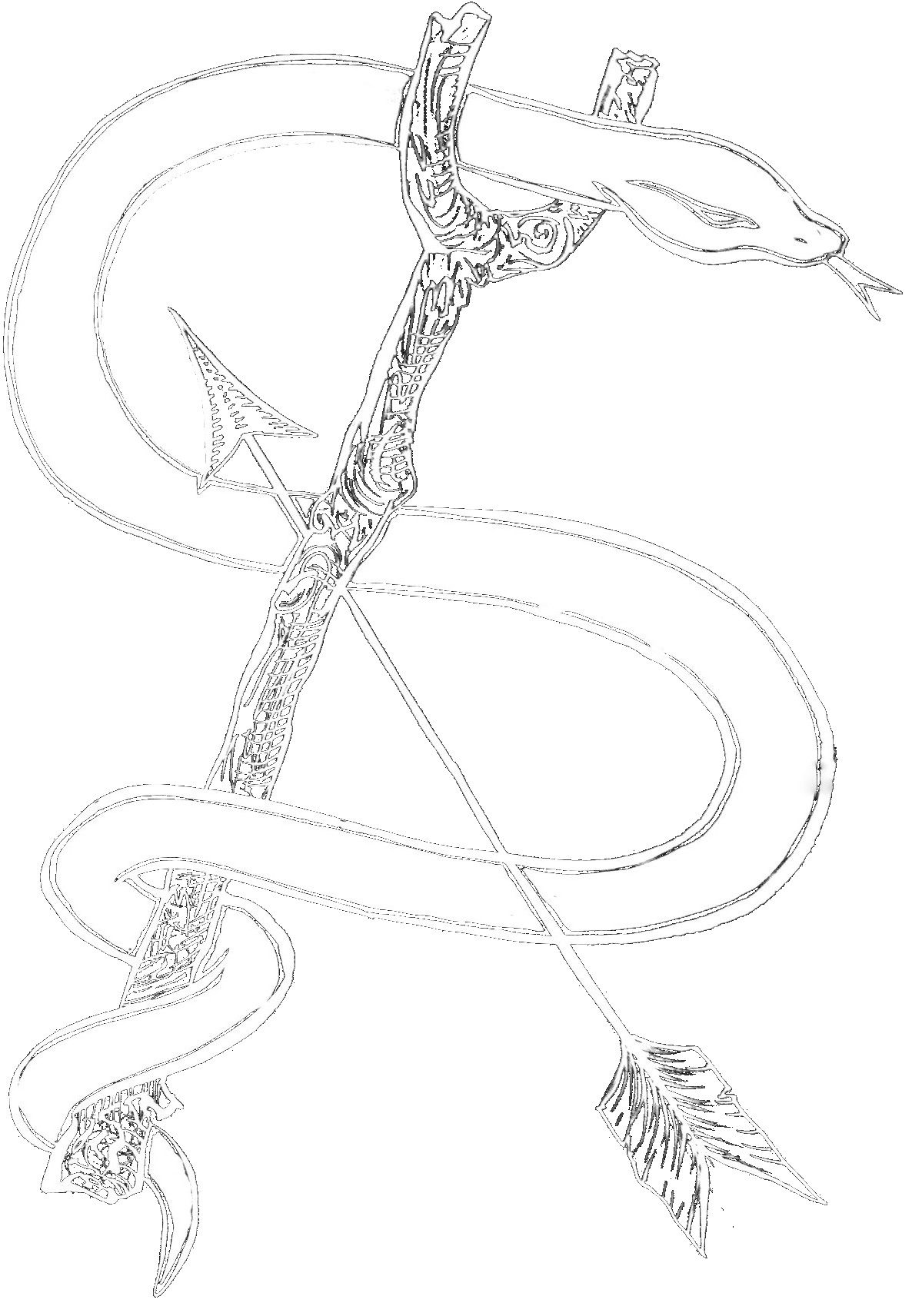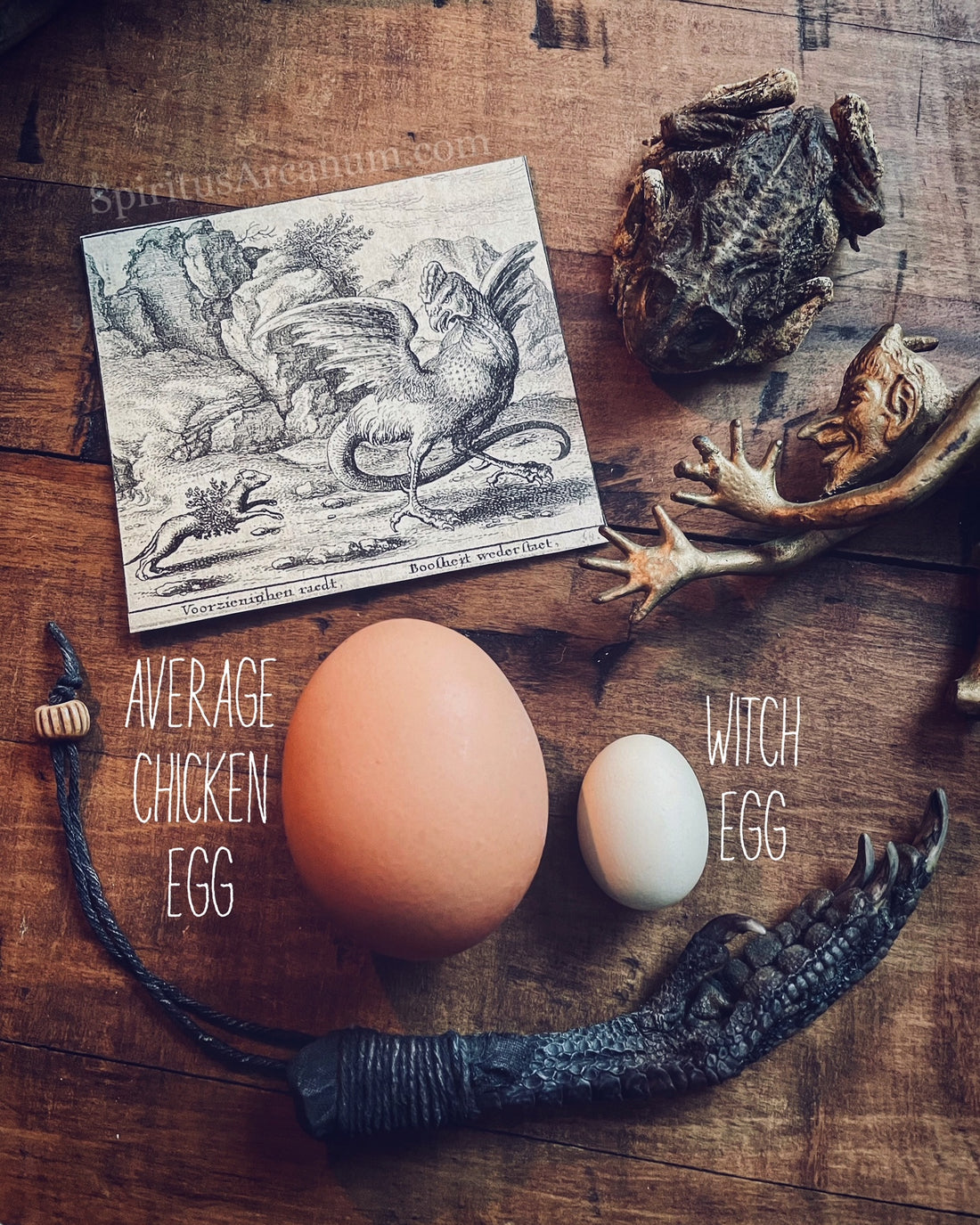
A rarity to behold, Witch Eggs occur when an egg is formed without a yolk, making the resultant eggs substantially smaller. This usually happens when a pullet (young hen) has just begun laying eggs. However, some chickens have been known to lay them occasionally throughout their lives. Also known as a Cock’s Egg, Fairy Egg, and the rather less alluring Fart Egg, there is much folklore which surrounds these curious little ova worth exploring.
It was once believed that such eggs were laid by male birds, hence the term Cock’s Eggs. Further, it was feared that the Devil might send a toad or serpent to incubate these eggs and the resultant creature would become a monstrosity, either a dreaded Cockatrice or a Basilisk - two creatures which are sometimes seen as one in the same, but which have some marked differences in origin and appearance.

The Basilisk & Cockatrice
The Basilisk derives its name from the Greek epithet basilikos. A term which means "imperial" or "royal." It was commonly known as 'King of the Serpents', and was often envisioned as a "Crowned" serpent. The Basilisk also had the power to kill both animals and plant life with a single glance, or with its deadly breath.
When we look at one of the earliest preserved accounts of the creature we are able to gather some clues about the creature which might have inspired the tales of the Basilisk:
"It is a native of the province of Cyrenaica, not more than 12 inches long, and adorned with a bright white marking on the head like a sort of diadem. It routs all snakes with its hiss, and does not move its body forward in manifold coils like other snakes but advancing with its middle raised high. It kills bushes not only by its touch but also by its breath, scorches up grass and bursts rocks. Its effect on other animals is disastrous: it is believed that once one was killed with a spear by a man on horseback and the infection rising through the spear killed not only the rider but also the horse."
-Pliny the Elder, Natural History 8
Fantastical tales of its venom aside, here we have mention of a North African serpent which raises itself up from the middle and has a white pattern like a diadem on its head. Though the pattern description may be a bit off for the species usually found in this region, a likely candidate for early inspiration of the basilisk is the cobra (Naja haje). It's interesting to note how the cobra, much like the basilisk and cockatrice, is also commonly given the role of kingship over serpents. Additionally, Pliny goes on to speak about how the natural enemy of the basilisk, and one of the only creatures which can withstand its venom, is the weasel. This is possibly a reference to the tendency for the real life mongoose to attack and kill cobras in the wild.

Though the terms tend to be interchangeable in contemporary usage, as mentioned earlier, the basilisk and cockatrice were originally two separate and distinct creatures, with the cockatrice only first being mentioned in the late 14th century. And while the basilisk has traditionally been seen as more serpentine and lacking wings, the cockatrice was commonly depicted with wings and features more like a cockerel.
As time moves on the description and image of the basilisk changes a bit and becomes confused, comingled, and intertwined with the cockatrice. Both creatures are said to appear with dragon-like characteristics and combined elements of both a rooster and a reptile, usually appearing with the body and/or tail of a serpent, and the legs and head of a rooster. One can imagine that the transition to seeing the basilisk as "crowned" by the cock's comb is both a furtherance of the diadem first mentioned by Pliny and a continued nod to its role of serpent king.
The confusion between the two seems to have first occurred when reference of the basilisk in Bartholomeus Anglicus' De proprietatibus rerum was translated in the late 14th century and the term basiliscus was replaced with cockatrice. That said, both creatures shared a venomous nature and killing glance. It would later be claimed that the only methods of killing either was to see its own reflection, or to hear the crow of a rooster which would make the creature fall dead.

Further differentiation appears in reference to how the two creatures are born. In the case of the Basilisk it is believed they are created when a Rooster lays an egg and it is incubated by either a Toad, or a Snake. Usually said to have been sent by Satan. Hence the concern about leaving Cock's Eggs lying around. The reverse is said of the Cockatrice wherein it is believed to be the product of a serpent egg being incubated by a Rooster, or Hen in some cases. Dependent upon the source there are often variations upon these stipulations. In some cases it is said that the constellation Sirius must be on the ascendant for such creatures to be born. In other accounts the eggs are instead incubated by witches.
Both the Basilisk and Cockatrice appear in heraldry such as in that of the town of Basle, Switzerland (take note of that locale for later). Though in a broader context the symbol of the Basilisk was often one associated with death or evil. Often standing in as representative of the Devil in Christian art. For instance, in some renditions of the heroics of Saint George, he is said to have slain a Basilisk instead of a dragon. Yet in alchemical operations the cremated ash of the Basilisk was said to be valuable in the transmutation of metals.

But what does any of this have to do with witchcraft?
Beyond the possibility for the spirits or images of these beasts to be conjured for protective amulets or malefic purposes, Cock’s Eggs were said to be used by witches and sorcerers as an ingredient in formulas for cursing. And popular lore claimed that to bring one into the house was to invite a ill fortune or illness into the home. Unless of course, one was already a witch.
So worrisome were these eggs that most god-fearing folks would immediately break them upon finding them. The preferred method being to toss them over the house, taking care to make it fully to the other side without touching the roof.
The widespread concern around the dangers posed by Witch Eggs is even more attested to by the records of a trial held in Basle, Switzerland in 1474 in which a Rooster was accused, put on trial, and found guilty of having laid an egg. The unfortunate bird was sentenced, condemned, and eventually burned alive in an execution which paralleled the solemnity and ceremony common to the burning of heretics and witches of the day.
So if you ever find yourself in the possession of one of these anomalies might I suggest you quickly toss it over the roof, save it for works of malefica, or if you're feeling particularly adventurous, place it in a serpent's nest and see what might be born.

The legend of the cock egg: https://www.muranochickenfarm.com/2019/02/the-legend-of-cock-egg.html
Olla Podrida. Frederick Marryat. Baudry's European Library, 1841
The Natural History. Pliny the Elder. John Bostock, M.D., F.R.S. H.T. Riley, Esq., B.A. London. Taylor and Francis, Red Lion Court, Fleet Street. 1855
Nature on Trial: The Case of the Rooster that Laid an Egg. E. V. Walter. Boston Studies in the Philosophy of Science Book Series Vol. 84.


